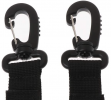Also maybe I should share more info about the room, just in case there is something horribly wrong to be spotted in it
So basically some months ago I had attempted to treat this room in a DIY fashion, my brother had some spare rockwool so I've made 6 acoustic panels, they are 120cm x 60cm x 16cm thick and they surround my listening position. There is also 6 smaller panels fitted into a narrow bookshelf in the far left corner trying to act as some sort of bass trap, and probably failing at it.
It looks like this:
everything orange except the curtain is those "acoustic panels"
this is the gap from the wall
The thing is, and maybe the problem of this, the material I've chosen to wrap them:
As you can see got two layers, the one on top fooled me into thinking sound would pass easily, but the one under it is actually pretty densely woven... unfortunately when I purchased it I wasn't aware that this would matter because noone told me and I hadn't done enough research, so I don't even know if these things are achieving anything positive =_=
I guess the the first step here is to measure the room with and without them.
The only problem is that the strip preventing them from falling forward is tied to the thing supporting them, so untie all those knots is just tedious, I'm thinking I will have to order online some hooks like these

to affix to the end of the strips so that I can quickly hang/remove the panels therefore I can't do that measurements soon.
But anyway, I'm honestly surprised that all my measures looks like garbage after all of that, makes me think this panels are actually doing nothing useful despite 16cm of rockwool due to the material wrapping them...
This is the RT60 in the part of the room I am right now btw:
so maybe they are still helping with that, I think it actually looked better when I had the desk in a different position, but the "excessive" amount of panels could be the reason the range 150 - 500Hz is sinking like that into the 200m in the graph? Maybe I should try and remove 2 panels from the sides and see if that raises
Let me know if you guys have any thoughts on it



